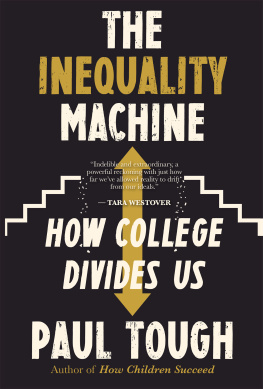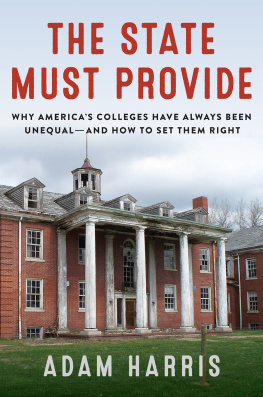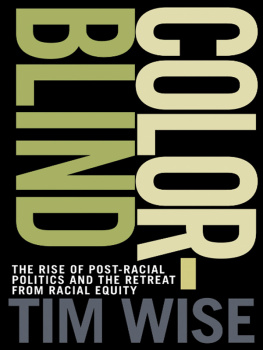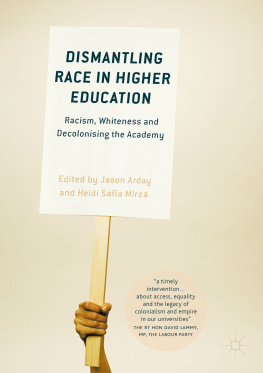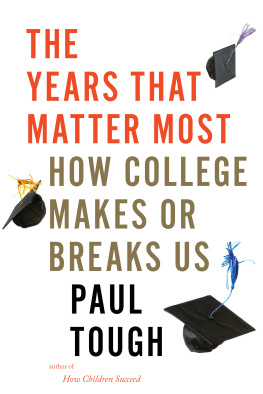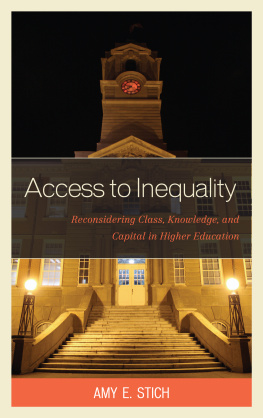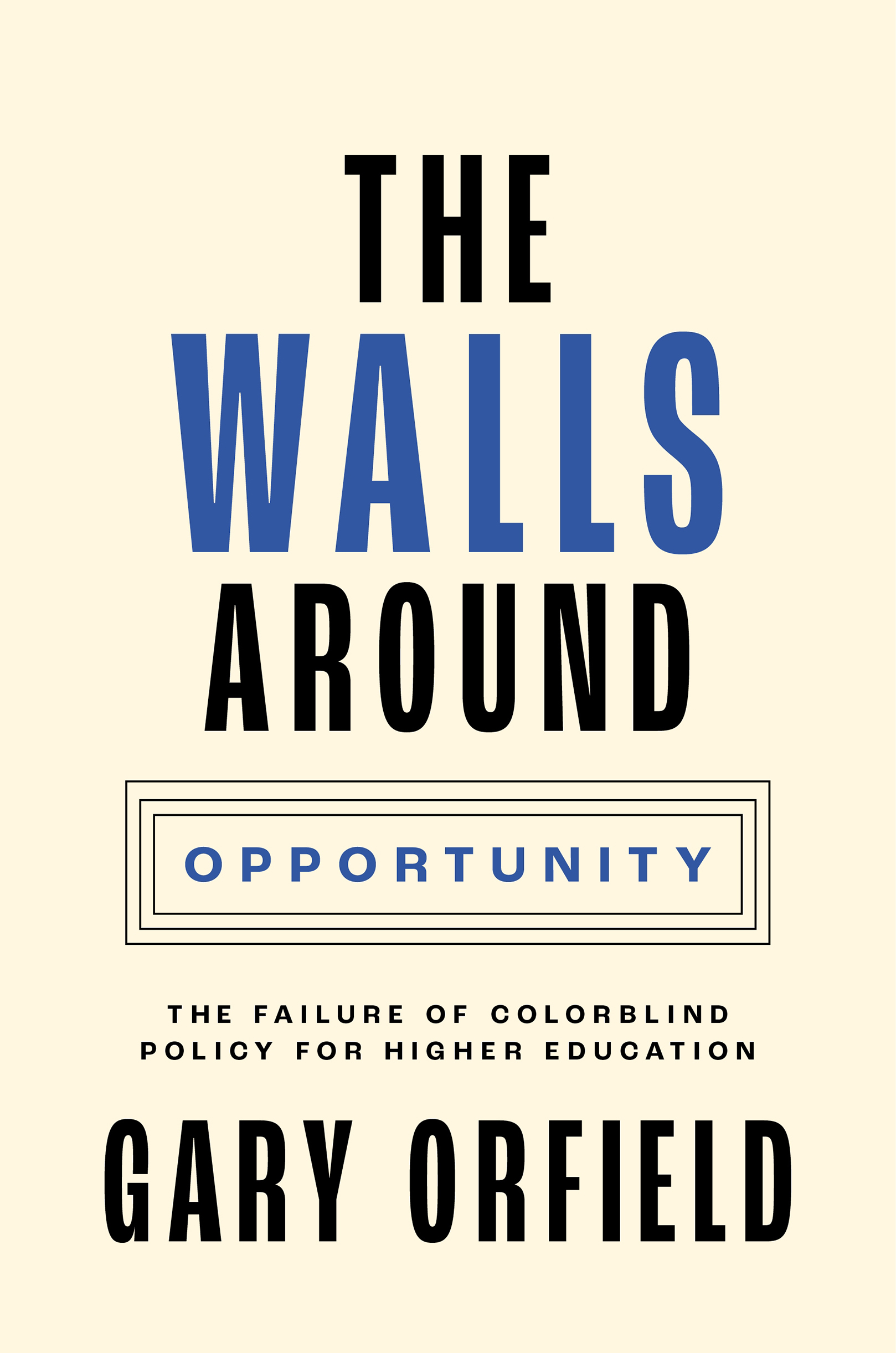THE WALLS AROUND OPPORTUNITY

AN INITIATIVE OF THE
UNIVERSITY OF MICHIGAN
WITH SUPPORT FROM THE
ANDREW W. MELLON FOUNDATION
Earl Lewis and Nancy Cantor, Series Editors
Other books in this series:
Eboo Patel, Out of Many Faiths: Religious Diversity and the American Promise
Scott E. Page, The Diversity Bonus: How Great Teams Pay Off in the Knowledge Economy
Earl Lewis and Nancy Cantor, editors, Our Compelling Interests: The Value of Diversity for Democracy and a Prosperous Society
The Walls around Opportunity
THE FAILURE OF COLORBLIND POLICY FOR HIGHER EDUCATION
GARY ORFIELD
PRINCETON UNIVERSITY PRESS
PRINCETON & OXFORD
Copyright 2022 by Gary Orfield
Princeton University Press is committed to the protection of copyright and the intellectual property our authors entrust to us. Copyright promotes the progress and integrity of knowledge. Thank you for supporting free speech and the global exchange of ideas by purchasing an authorized edition of this book. If you wish to reproduce or distribute any part of it in any form, please obtain permission.
Requests for permission to reproduce material from this work should be sent to
Published by Princeton University Press
41 William Street, Princeton, New Jersey 08540
99 Banbury Road, Oxford OX2 6JX
press.princeton.edu
All Rights Reserved
Library of Congress Cataloging-in-Publication Data
Names: Orfield, Gary, author.
Title: The walls around opportunity : the failure of colorblind policy for higher education / Gary Orfield.
Description: Princeton : Princeton University Press, [2022] | Series: Our compelling interests; 4 | Includes bibliographical references and index.
Identifiers: LCCN 2021042083 (print) | LCCN 2021042084 (ebook) | ISBN 9780691227412 (hardback) | ISBN 9780691236827 (ebook)
Subjects: LCSH: Universities and collegesUnited StatesAdmission. | Minority college studentsSocial conditionsUnited States. | Affirmative action programs in educationUnited States. | Educational equalizationUnited States. | Higher education and stateUnited States.
Classification: LCC LC212.42 .O74 2022 (print) | LCC LC212.42 (ebook) | DDC 378.1/610973dc23/eng/20211006
LC record available at https: / /lccn.loc.gov/2021042083
LC ebook record available at https: / /lccn.loc.gov/2021042084
Version 1.0
British Library Cataloging-in-Publication Data is available
Editorial: Eric Crahan, Barbara Shi
Jacket Design: Lauren Smith
Production: Danielle Amatucci
Publicity: Julia Haav, Kate Farquhar-Thomson
Copyeditor: Ashley Moore
CONTENTS
- vii
AUTHORS NOTE
AMERICAN COLLEGES and universities are institutions of immense, sometimes transformative, power, but they are doing far too little to help resolve the dangerous stratification and racial divisions in our society as it goes through the last stage of a white majority. The failure is long-standing and severe, and it may be getting even worse. It cannot be changed without making equity in our colleges a central commitment and working hard to devise means that will actually change the opportunities and outcomes. Affirmative action is a limited policy but is under severe threat in the Supreme Court. Our high schools are resegregated after the courts terminated integration plans, and offer too little support to students of color. Many good people are doing something to address equity on campus and in policy. Things would certainly be even worse without those efforts, and they have created models of what could bring larger changes, but its not enough to overcome the powerful sorting pressures of our stratified society and its weak current policies. Major new energy or resources have not been put into civil rights policies for a generation. I know the transformative power of college in my own life, with my own students, and in my research, and I know we can do much more to bring into the center of our society and economy the major groups that have always been on the margin.
I was the first one in my family to go to college. I understand in a special way how transformative it can be. My grandfather was an immigrant from a farm in Norway with an elementary education. My father and mother were very talented but were only able to go through high school during the Great Depression. I became a professor at several of the worlds great universities. I did not do it on my own. I had a loving, supportive family, and my dad worked hard to be able to live in an area with good schools. I went to one of the best high schools in my state. There was a great low-cost public university, the University of Minnesota, with talented and supportive professors, so I could live at home, pay modest tuition, commute, and be ready for great graduate schools. I went to college with almost a year of credits from high school. I had saved more than two years tuition from my grocery store work, I got scholarships, and could pay my other costs with summer jobs. My first survey research was about a proposal to raise the tuition at the university. I was in student government and we systematically surveyed students about their economic situation and what would happen if the tuition went up. Though tuition was at what wed now consider an extremely low level, two-thirds of the students were commuters and many reported that they were struggling and would have to drop out. We sent the report to the state legislature and were stunned when they voted the tuition hike down, putting me in conflict with the universitys administrators but maybe saving college access for a number of students. It was my first lesson in the power of research for equity. It showed me that what administrators considered insignificant was a major barrier for many.
I have written extensively about civil rights issues in colleges, public schools, and other institutions; been actively involved as a witness and a court-appointed expert in major civil rights cases; and participated in admissions decisions. I had opportunities to study community colleges and universities in metro Chicago with a wonderful team of University of Chicago students when I was teaching there, to carry out a statewide study of opportunity in high schools and colleges across Indiana, and to do studies of the Atlanta region and other major metro areas. There have been many opportunities since. It has been very depressing to observe, decade after decade, stratification intensifying leaving largely untouched university policies that have the effect of perpetuating inequalities as higher education becomes ever more critical to family and community success.
I believe higher education policy is one of the most important forces that shape our society, but it is usually out of public sight. Often higher education policy is managed in ways that all institutions get something and the status quo is not really challenged. Thats not good enough. My work focuses on issues of racial equity. It is clear that our higher education policies are not closing the racial gaps in our society and are, in some ways, legitimating and even intensifying them. Im glad that higher education was a major issue in the 2020 campaign, but I think too much of the attention was on the admittedly important issue of student debt held by graduates and on community college tuition, not the factors that most directly affect the future of equity on our campuses.


